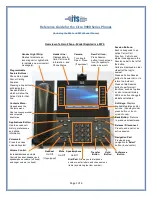
General Features
194
Features Guide
Toll Restriction
Description
Toll Restriction is a system programmable feature that, in conjunction with the assigned Class
of Service, can prohibit certain extension users from placing unauthorized toll calls.
The software contained in Toll Restriction to allow user access to the network must be
upgraded to recognize newly established network area codes and exchange codes as they are
placed into service.
Failure to upgrade the premises systems or peripheral equipment to recognize the new codes
as they are established will restrict the customer and the customer's employees from gaining
access to the network and to these codes.
Every extension is programmed to belong to one of eight Classes of Service. Each Class of
Service is programmed to have a toll restriction level for day mode and night mode.
There are eight toll restriction levels available. Toll restriction level 1 is the highest level and
the level 8 is the lowest. That is, level 1 allows all toll calls and levels 7 and 8 disallows all toll
calls. Levels 2 through 6 are used to restrict calls by combining pre-programmed deny and
excepted code tables.
Denied Code Tables
An outgoing outside call made by an extension with a toll restriction level between 2 and 6 is
first checked against the selected Denied Code Tables. If the leading digits of the dialed
number (not including the line access code) are not found in the table, the call is made. There
are five system programs for Denied Code Tables:
[301]-[305] TRS Denied Code Entry for
Levels 2 through 6:
Each program is used to make up a Denied Code Table for Levels 2
through 6 respectively.
Complete every table by storing numbers that are to be prohibited. These numbers are defined
as denied codes. Each table can store up to 20 denied codes, each consisting of a maximum of
ten digits.
Excepted Code Tables
These tables are used to override a programmed denied code. A call denied by the selected
Denied Code Tables is checked against the selected Excepted Code Tables, and if a match is
found, the call is made.
There are five system programs for these tables:
[306]-[310] TRS Excepted Code Entry for Levels 2 through 6:
Each program is used to
make up an Excepted Code Table for Levels 2 through 6.
Complete every table by storing numbers that are exceptions to the denied codes. These
numbers are defined as excepted codes. Each table can store up to five excepted codes, each
consisting of a maximum of ten digits.
Summary of Contents for KX-TA1232
Page 8: ...Table of Contents 8 Features Guide...
Page 9: ...General Features Features Guide 9 Section 1 General Features...
Page 32: ...General Features 32 Features Guide User Manual References 2 2 2 Flexible Button Assignment...
Page 71: ...General Features Features Guide 71 User Manual References Not applicable...
Page 81: ...General Features Features Guide 81 User Manual References Not applicable...
Page 97: ...General Features Features Guide 97 User Manual References 4 3 40 Doorphone Call...
Page 216: ...General Features 216 Features Guide...
Page 217: ...Tone Ring Tone Features Guide 217 Section 2 Tone Ring Tone...
Page 220: ...Tone Ring Tone 220 Features Guide...
Page 221: ...Index 221 Section 3 Index...
















































